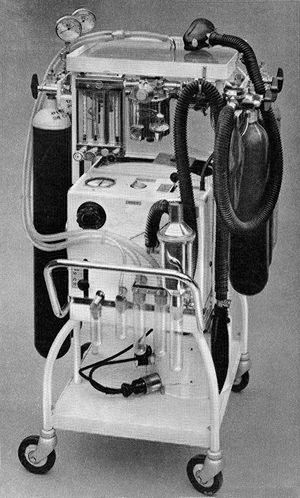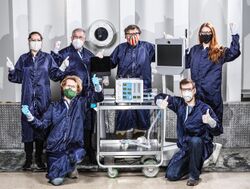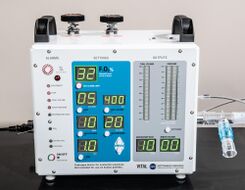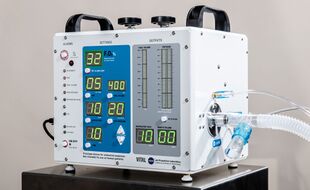منفسة
| منفسة | |
|---|---|
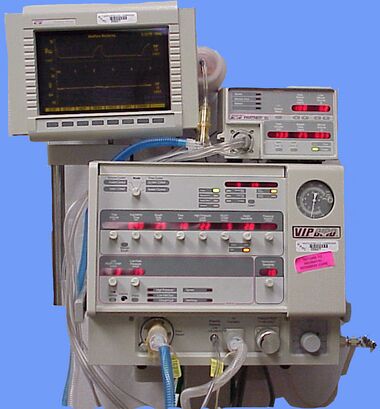 The Bird VIP Infant ventilator | |
| التخصص | طب الصدر |
المنفِّسة أو جهاز التنفس الاصطناعي ventilator هو جهاز يعطي تنفس صناعي (تهوية ميكانيكية) بنقل هواء قابل للتنفس إلى ومن الرئتين، لتحقيق التنفس لمريض غير قادر طبيعياً على التنفس، أو أنه يتنفس بقدر غير كافي. والمنفـِّسات هي أجهزة محوسبة يحكمها معالج دقيق، ولكن يمكن مساعدة المرضى على التنفس أيضاً باستخدام قناع ذو صمام وكيس بسيط، يـُشغـَّل يدوياً. وتـُستـَخدَم المنفسات أساساً في طب الحالات الحرجة والرعاية المنزلية و طب الطوارئ (كوحدات قائمة بذاتها) وفي علم التخدير (كمكون في جهاز تخدير).
وظيفة الجهاز
تتألف المنفسة مبدئياً من خزان هواء، يزود بالهواء أو الأكسجين، مجموعة من الصمامات والأنابيب، ووصلة قابلة للاستبدال مخصصة لوصل المريض بالجهاز. يعمل الجهاز على ضغط الهواء أو الأكسجين بحيث أنه عند تحرير الضغط سيتم الشهيق للهواء إلى رئتي المريض بسبب مرونة الرئتين، ويتم الزفير عن طريق صمام أحادي الجهة يسمح للهواء بالخروج فقط من دارة تنفس المريض.
التاريخ
The history of mechanical ventilation begins with various versions of what was eventually called the iron lung, a form of noninvasive negative-pressure ventilator widely used during the polio epidemics of the twentieth century after the introduction of the "Drinker respirator" in 1928, improvements introduced by John Haven Emerson in 1931,[1] and the Both respirator in 1937. Other forms of noninvasive ventilators, also used widely for polio patients, include Biphasic Cuirass Ventilation, the rocking bed, and rather primitive positive pressure machines.[1]
In 1949, John Haven Emerson developed a mechanical assister for anaesthesia with the cooperation of the anaesthesia department at Harvard University. Mechanical ventilators began to be used increasingly in anaesthesia and intensive care during the 1950s. Their development was stimulated both by the need to treat polio patients and the increasing use of muscle relaxants during anaesthesia. Relaxant drugs paralyse the patient and improve operating conditions for the surgeon but also paralyse the respiratory muscles.
جائحة كوڤيد-19
The COVID-19 pandemic has led to shortages of essential goods and services - from hand sanitizers to masks to beds to ventilators. Several countries have already experienced a shortage of ventilators.[2] Fifty-four governments, including many in Europe and Asia, imposed restrictions on medical supply exports in response to the coronavirus pandemic.[3]
The number of ventilators varies by country. When data is often not available for ventilators specifically, estimates are sometimes made based on the number of intensive care unit beds available, which often contain ventilators.[4]
الولايات المتحدة
In 2006, president George W. Bush signed the Pandemic and All-Hazards Preparedness Act, which created the Biomedical Advanced Research and Development Authority (BARDA) within the United States Department of Health and Human Services. In preparation for a possible epidemic of respiratory disease, the newly created office awarded a $6 million contract to Newport Medical Instruments, a small company in California, to make 40,000 ventilators for under $3,000 apiece. In 2011, Newport sent three prototypes to the Centers for Disease Control. In 2012, Covidien, a $12 billion/year medical device manufacturer, which manufactured more expensive competing ventilators, bought Newport for $100 million. Covidien delayed and in 2014 cancelled the contract.
BARDA started over again with a new company, Philips, and in July 2019, the FDA approved the Philips ventilator, and the government ordered 10,000 ventilators for delivery in mid-2020.[5]
On April 23, 2020, NASA reported building, in 37 days, a successful COVID-19 ventilator, named VITAL ("Ventilator Intervention Technology Accessible Locally"). On April 30, NASA reported receiving fast-track approval for emergency use by the United States Food and Drug Administration for the new ventilator.[6][7][8] On May 29, NASA reported that eight manufacturers were selected to manufacture the new ventilator.[9]
انظر أيضاً
- Artificial ventilation
- Joseph Stoddart
- Open-source hardware
- Respiratory therapy
- Robert Martensen
- Two-balloon experiment
- Iron lung (Tank ventilator)
- Liquid ventilator
الهامش
- ^ أ ب Geddes, LA (2007). "The history of artificial respiration". IEEE Engineering in Medicine and Biology Magazine. 26 (6): 38–41. doi:10.1109/EMB.2007.907081. PMID 18189086. S2CID 24784291.
- ^ "Allocating Ventilators in a Pandemic". healthmanagement.org (in الإنجليزية الأمريكية). 2020-03-24. Retrieved 2020-03-25.
- ^ "Export restrictions threaten ventilator availability". politico.com (in الإنجليزية الأمريكية). 2020-03-24. Retrieved 2020-03-25.
- ^ Prachi Singh; Shamika Ravi; Sikim Chakraborty (2020-03-24). "COVID-19 | Is India's health infrastructure equipped to handle an epidemic?". Brookings Institution. Retrieved 2020-06-07.
- ^ Nicholas Kulish, Sarah Kliff and Jessica Silver-Greenberg (March 29, 2020). "The U.S. Tried to Build a New Fleet of Ventilators. The Mission Failed. As the coronavirus spreads, the collapse of the project helps explain America's acute shortage". New York Times.
- ^ Inclán, Bettina; Rydin, Matthew; Northon, Karen; Good, Andrew (30 April 2020). "NASA-Developed Ventilator Authorized by FDA for Emergency Use". NASA. Retrieved 1 May 2020.
- ^ Good, Andrew; Greicius, Tony (April 23, 2020). "NASA Develops COVID-19 Prototype Ventilator in 37 Days". NASA. Retrieved April 24, 2020.
- ^ Wall, Mike (April 24, 2020). "NASA engineers build new COVID-19 ventilator in 37 days". Space.com. Retrieved April 24, 2020.
- ^ Inclán, Bettina; Rydin, Matthew; Northon, Karen; Good, Andrew (May 29, 2020). "Eight US Manufacturers Selected to Make NASA COVID-19 Ventilator". NASA. Retrieved May 29, 2020.

